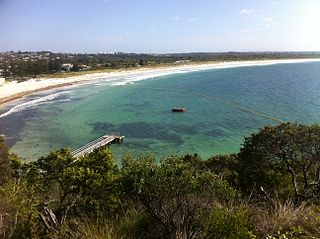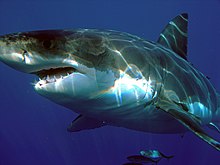
A shark attack is an attack on a human by a shark. Every year, around 80 unprovoked attacks are reported worldwide. Despite their rarity, many people fear shark attacks after occasional serial attacks, such as the Jersey Shore shark attacks of 1916, and horror fiction and films such as the Jaws series. Out of more than 500 shark species, only three are responsible for a double-digit number of fatal, unprovoked attacks on humans: the great white, tiger, and bull. The oceanic whitetip has probably killed many more shipwreck and plane crash survivors, but these are not recorded in the statistics. Humans are not part of a shark's normal diet. Sharks usually feed on small fish and invertebrates, seals, sea lions, and other marine mammals. A shark attack will usually occur if the shark feels curious or confused.

A shark net is a submerged section of gillnets placed at beaches designed to intercept large marine animals including sharks, with the aim to reduce the likelihood of shark attacks on swimmers. Shark nets used are gillnets which is a wall of netting that hangs in the water and captures the marine animals by entanglement, however only around 10% of catch is the intended target shark species. The nets in Queensland, Australia, are typically 186m long, set at a depth of 6m, have a mesh size of 500mm and are designed to catch sharks longer than 2m in length. The nets in New South Wales, Australia, are typically 150m long, set on the sea floor, extending approximately 6m up the water column, are designed to catch sharks longer than 2m in length. Shark nets do not create an exclusion zone between sharks and humans, and are not to be confused with shark barriers.

The Jersey Shore shark attacks of 1916 were a series of shark attacks along the coast of New Jersey, in the United States, between July 1 and 12, 1916, in which four people were killed and one critically injured. The incidents occurred during a deadly summer heat wave and polio epidemic in the United States that drove thousands of people to the seaside resorts of the Jersey Shore. Since 1916, scholars have debated which shark species was responsible and the number of animals involved, with the great white shark and the bull shark most frequently cited.

Shark cage diving is underwater diving or snorkeling where the observer remains inside a protective cage designed to prevent sharks from making contact with the divers. Shark cage diving is used for scientific observation, underwater cinematography, and as a tourist activity. Sharks may be attracted to the vicinity of the cage by the use of bait, in a procedure known as chumming, which has attracted some controversy as it is claimed to potentially alter the natural behaviour of sharks in the vicinity of swimmers.

North West Island is a coral cay in the southern Great Barrier Reef, located 75 kilometres northeast of Gladstone, Queensland. North West Island forms part of Capricornia Cays National Park and with an area of 1.05 km2, the island is the second largest coral cay in the Great Barrier Reef. It is part of the Capricornia Cays Important Bird Area.
Rodney Winston Fox is an Australian film maker, conservationist, survivor of an attack by a great white shark, and one of the world's foremost authorities on that species. He was inducted into the International Scuba Diving Hall of Fame in 2007. He was born in Adelaide.

Greenmount Beach is a beach located in Coolangatta on Queensland's Gold Coast in Australia.

Gracetown is a small town in Western Australia. It is located 269 kilometres (167 mi) south of the Perth central business district, and 21.5 kilometres (13.4 mi) north-west of the township of Margaret River in the Augusta-Margaret River Shire Council area on the coast at Cowaramup Bay.

Michael Eugene Fanning is an Australian professional surfer who was crowned champion of the Association of Surfing Professionals/World Surf League (ASP/WSL)'s World Tour in 2007, 2009 and 2013. In 2015, he survived a shark attack by what is suspected to be a great white shark during the J-Bay Open finals in Jeffreys Bay.
The Summer of the Shark refers to the coverage of shark attacks by American news media in the summer of 2001. The sensationalist coverage of shark attacks began in early July following the Fourth of July weekend shark attack on 8-year-old Jessie Arbogast, and continued almost unabated—despite no evidence for an actual increase in attacks—until the September 11 terrorist attacks shifted the media's attention away from beaches. The Summer of the Shark has since been remembered as an example of tabloid television perpetuating a story with no real merit beyond its ability to draw ratings.
A drum line is an unmanned aquatic trap used to lure and capture large sharks using baited hooks. They are typically deployed near popular swimming beaches with the intention of reducing the number of sharks in the vicinity and therefore the probability of shark attack. Drum lines are often used in association with shark nets, which results in shark mortality. However SMART drum lines can be used to move sharks, which greatly reduces shark and bycatch mortality. The use of drum lines has been successful in reducing shark attacks in the areas where they are installed. The topic of shark culling became an international controversy and sparked public demonstrations and vocal opposition, particularly from environmentalists, animal welfare advocates and ocean activists.

Wildlife attacks in Australia occur every year from several different native species, including snakes, spiders, freshwater and saltwater crocodiles, various sharks, cassowaries, kangaroos, stingrays and stonefish and a variety of smaller marine creatures such as bluebottles, blue-ringed octopus, cone shells and jellyfish.

The Western Australian shark cull is the common term for a former state government policy of capturing and killing large sharks in the vicinity of swimming beaches by use of baited drum lines. The policy was implemented in 2014 to protect human swimmers from shark attack following the deaths of seven people on the Western Australian coastline in the years 2010 to 2013. National public demonstrations opposing the policy attracted international attention to the issue. In September 2014 the seasonal setting of drum lines was abandoned following a recommendation made by the Western Australian Environment Protection Authority. From December 2014 to March 2017, the special deployment of drum lines was permitted in cases where sharks were deemed to present a serious threat to public safety. This policy allowed the government of Western Australia to kill "high-hazard" sharks it found to be a threat to humans; the policy was criticized by senator Rachel Siewart for damaging the environment. In March 2017 the use of drum lines was abandoned by the newly elected West Australian state government. In August 2018 following continual shark attacks the West Australian state government reversed their position and announced a 12-month trial of "SMART" drumlines along Western Australia's South West coast, near Gracetown.

A total of 24 people have been killed by sharks in South Australian waters since the establishment of the colony in 1836. Prior to 2014, there had been 82 recorded shark attacks in South Australia. 20 of those have involved a single fatality. Victims were involved in a range of aquatic activities, including surfing, diving, spear-fishing, snorkeling, boating and swimming. Six of the fatalities occurred off the coast of greater metropolitan Adelaide, with the remainder distributed across South Australia's extensive coastline. Many of the fatal attacks have been attributed to great white sharks.
A shark barrier is seabed-to-surface protective barrier that is placed around a beach to protect people from shark attacks. Often confused with shark nets, shark barriers form a fully enclosed swimming area that prevents sharks from entering. Shark barrier design has evolved from rudimentary fencing materials to netted structures held in place with buoys and anchors. Recent designs have used plastics to increase strength, versatility and to reduce the environmental damage of bycatch.

Middleton Beach shark barrier, also referred to as the Albany shark barrier and the Ellen Cove shark barrier, is a shark barrier to prevent sharks entering the main swimming area at Ellen Cove at the southern end of Middleton Beach, a popular swimming beach in Albany in the Great Southern region of Western Australia.

There are a range of shark attack prevention techniques employed to reduce the risk of shark attack and keep people safe. They include removing sharks by various fishing methods, separating people and sharks, as well as observation, education and various technology-based solutions.

Shark culling is the deliberate killing of sharks by government authorities, usually in response to one or more shark attacks. The term "shark control" is often used by governments when referring to culls. Shark culling has been criticized by environmentalists, conservationists and animal welfare advocates—they say killing sharks harms the marine ecosystem and is unethical. Government officials often cite public safety as a reason for culling. The impact of culling is also minor compared to bycatch with 50 million sharks caught each year by the commercial fishing industry.














